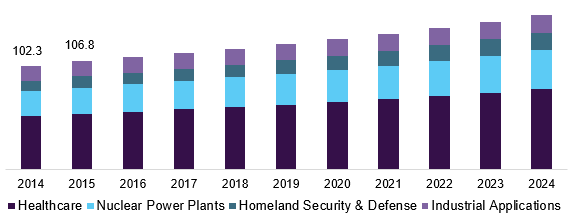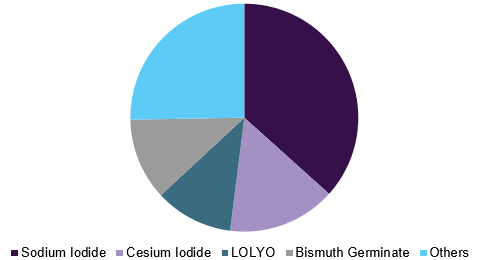- Home
- »
- Advanced Interior Materials
- »
-
Inorganic Scintillators Market Size Report, 2030GVR Report cover
![Inorganic Scintillators Market Size, Share & Trends Report]()
Inorganic Scintillators Market Size, Share & Trends Analysis Report By Product (Alkali Halides, Oxide Compounds, Rare Earth Metals) By Material (Sodium Iodide) By End Use, And Segment Forecasts, 2024 - 2030
- Report ID: GVR-1-68038-191-7
- Number of Report Pages: 80
- Format: PDF, Horizon Databook
- Historical Range: 2018 - 2022
- Forecast Period: 2024 - 2030
- Industry: Advanced Materials
Report Overview
The global inorganic scintillators market size was valued at USD 512.9 million in 2023 and is anticipated to grow at a CAGR of 7.4% from 2024 to 2030. The market growth is driven by the increasing demand for radiation detection across various sectors, particularly in medical imaging, nuclear power plants, and homeland security. Inorganic scintillators, such as sodium iodide and cesium iodide, are essential for converting high-energy radiation into visible light, making them critical for applications such as positron emission tomography (PET) and single-photon emission computed tomography (SPECT) in healthcare. Moreover, advancements in scintillator technology have improved their performance, sensitivity, and durability, further enhancing their adoption.

Regulations play a crucial role in shaping the global inorganic scintillators market, particularly by influencing the development, production, and usage of these materials in various industries. One significant regulation is the Euratom Treaty in the European Union, which mandates strict safety and radiation protection standards for nuclear materials, thereby driving the demand for high-quality inorganic scintillators in medical imaging and radiation detection. Similarly, the U.S. Nuclear Regulatory Commission (NRC) imposes stringent radiation safety guidelines, directly impacting the market by requiring advanced scintillation materials in nuclear power plants and research facilities. Furthermore, initiatives such as the International Atomic Energy Agency’s (IAEA) Nuclear Security Plan promote using scintillators in global security applications, enhancing market growth. Environmental regulations, such as the Restriction of Hazardous Substances (RoHS) Directive in electronics, also impact the market by limiting the use of hazardous materials in scintillator production, pushing manufacturers towards safer alternatives. These regulations collectively shape the innovation, production, and adoption of inorganic scintillators worldwide.
The rising awareness of safety regulations related to radiation exposure also propels the need for reliable radiation detection systems, thereby fostering market growth. Additionally, the expansion of nuclear facilities and the increasing focus on security measures post-nuclear incidents contribute to the heightened demand for inorganic scintillators in various applications.
Product Insights
The alkali halides segment accounted for 62.0% of the market revenue in 2023 attributed to the widespread use of alkali halides in various applications, including medical imaging, radiation detection, and nuclear physics. Alkali halides, such as sodium iodide and cesium iodide, are preferred for their high light yield and efficient energy resolution, making them ideal for detecting and measuring ionizing radiation.
The rare earth metals segment is expected to grow at a CAGR of 7.6% from 2024 to 2030. Rare earth metals, including materials such as lutetium oxyorthosilicate (LSO) and gadolinium oxyorthosilicate (GSO), are gaining traction due to their superior performance characteristics, such as higher density and better energy resolution compared to traditional scintillators. These properties make rare earth metals highly suitable for advanced medical imaging techniques and high-energy physics experiments.
Material Insights
The sodium iodide segment dominated the market in 2023 attributed to its extensive application in various fields, such as medical imaging, environmental monitoring, and radiation detection. Sodium Iodide (NaI) scintillators are highly valued for their excellent light yield and energy resolution, which make them particularly effective in detecting gamma rays and other forms of ionizing radiation. The widespread adoption of sodium iodide in both commercial and research settings is driving revenue growth.
The cesium iodide segment is expected to grow fastest from 2024 to 2030. Cesium Iodide (CsI) scintillators are known for their high density and effective atomic number, which enhance their performance in high-energy physics experiments and advanced medical imaging techniques. Additionally, CsI scintillators offer better resolution and efficiency compared to some traditional materials, making them increasingly attractive for new and emerging technologies. The anticipated growth is indicative of the broader trend towards more advanced and efficient scintillation materials, catering to the evolving demands of various high-tech industries.
End Use Insights
The healthcare segment held the largest revenue share in 2023 primarily driven by the extensive use of inorganic scintillators in medical imaging technologies such as X-ray imaging, computed tomography (CT) scans, and PET scans. The high demand for accurate and efficient diagnostic tools in the healthcare sector, coupled with the increasing prevalence of chronic diseases and the aging population, has significantly contributed to the substantial revenue generated by this segment.

The industrial applications segment is expected to grow fastest over the forecast period. This segment encompasses a wide range of applications, including environmental monitoring, security, and defense. The growing need for radiation detection and measurement in these industries is driving the demand for inorganic scintillators. For instance, in environmental monitoring, scintillators are used to detect and measure radiation levels to ensure safety and compliance with regulatory standards. In the security and defense sector, they are employed in radiation detection equipment to prevent illicit trafficking of radioactive materials.
Regional Insights
North America dominated the global inorganic scintillators market with a revenue share of 40.8% in 2023 pertaining to the region's advanced healthcare infrastructure, substantial research and development investments, and the presence of major industry players. The high adoption rate of advanced medical imaging technologies and radiation detection systems in various industries has boosted the market’s growth in this region.
U.S. Inorganic Scintillators Market Trends
The U.S. held a significant market share of the North America inorganic scintillators market in 2023. This substantial market share can be attributed to the country’s robust healthcare sector, extensive use of scintillators in medical diagnostics, and strong focus on nuclear safety and security. The U.S. government’s support for scientific research and technological advancements further propels the market.
Europe Inorganic Scintillators Market Trends
Europe accounted for a significant share of the global inorganic scintillators market revenue in 2023. The region’s well-established healthcare systems and stringent regulatory standards for radiation safety have driven the demand for inorganic scintillators. Europe’s focus on environmental monitoring and nuclear energy has also contributed to the market’s growth.
The UK is a significant player in the European inorganic scintillators market, benefiting from its advanced medical infrastructure and active research community. The country’s emphasis on early disease detection and treatment and its commitment to nuclear safety support the demand for high-quality scintillation materials.
Asia Pacific Inorganic Scintillators Market Trends
The Asia Pacific inorganic scintillators market is expected to grow at a CAGR of 7.7% from 2024 to 2030. Rapid industrialization, increasing healthcare investments, and growing awareness of radiation safety are key factors driving this growth. Countries in the region are increasingly adopting advanced scintillation technologies for medical imaging and industrial applications.
China, as a major contributor to the APAC market, is experiencing significant growth in the inorganic scintillators sector. The country’s expanding healthcare infrastructure, rising investments in nuclear energy, and focus on technological innovation are propelling the demand for scintillation materials. China’s commitment to enhancing its radiation detection capabilities further boosts the market.
Middle East and Africa (MEA)Inorganic Scintillators Market Trends
The MEA region is projected to experience the fastest growth in the inorganic scintillators market over the forecast period. This growth is driven by increasing investments in healthcare infrastructure, rising awareness of radiation safety, and the region’s efforts to develop its nuclear energy sector. The adoption of advanced scintillation technologies in various applications is expected to accelerate market expansion in MEA.
Key Companies & Market Share Insights
Some of the major companies in the global inorganic scintillators market include Saint-Gobain S.A., Hamamatsu Photonics K.K., Dynasil Corporation, Hitachi Metals, Ltd., and others.
-
Saint-Gobain S.A. offers advanced scintillation materials and comprehensive range of products, including scintillation crystals, detectors, and radiation measurement solutions.
-
Dynasil Corporation designs and manufactures scintillation materials and detection systems. The company’s product portfolio includes innovative solutions for medical imaging, industrial non-destructive testing, and environmental monitoring.
Key Inorganic Scintillators Companies:
The following are the leading companies in the inorganic scintillators market. These companies collectively hold the largest market share and dictate industry trends.
- Molex
- Xymox Technologies, Inc.
- Douglas Corporation
- Dyna-Graphics Corporation
- GOT Interface
- Esterline
- EPEC LLC
- Butler Technologies, Inc.
- Design Mark Industries, Inc.
- Nelson Miller
Recent Developments
-
In November 2023, Tibidabo Scientific Industries, a leading provider of advanced scientific solutions, announced the acquisition of LLA Instruments. This strategic move expands Tibidabo's portfolio to include innovative products for material detection and identification, catering to a diverse range of applications.
-
In October 2023, Hitachi Group announced that its Healthcare Business Division would be transferred to Hitachi High-Tech, a wholly owned subsidiary. This strategic move aims to enhance the group's healthcare capabilities and drive innovation in diagnostic, treatment, and digital solutions.
Inorganic Scintillators Market Scope
Report Attribute
Details
Market size value in 2024
USD 547.8 million
Revenue forecast in 2030
USD 838.8 million
Growth rate
CAGR of 7.4% from 2024 to 2030
Historical data
2018 - 2022
Forecast period
2024 - 2030
Quantitative units
Revenue in USD million, and CAGR from 2024 to 2030
Report coverage
Volume & revenue forecast, company ranking, competitive landscape, growth factors, and trends
Segments covered
Product, material, end use
Key companies profiled
Dynasil Corporation of America, Hamamatsu Photonics K.K., Hitachi Metals Group, Detec, Rexon Components, Inc., Saint-Gobain S.A., Scintacor, Toshiba Materials Co., Ltd., EPIC Crystal Co., Ltd., Amcrys, Shanghai Siccas High Technology Corporation, Alpha Spectra, Inc, Nihon Kessho Kogaku Co., Ltd.
Customization scope
Free report customization (equivalent up to 8 analysts working days) with purchase. Addition or alteration to country, regional & segment scope.
Pricing and purchase options
Avail customized purchase options to meet your exact research needs. Explore purchase options
Global Inorganic Scintillators Market Report Segmentation
This report forecasts revenue & volume growth of the inorganic scintillators market and provides an analysis of the latest industry trends in each of the sub-segments from 2018 to 2030. For this study, Grand View Research has segmented the global agrochemicals market report based on product, material, and end use:
-
Product Outlook (Revenue, USD Million, 2018 - 2030)
-
Alkali Halides
-
Oxide Compounds
-
Rare Earth Metals
-
-
Material Outlook (Revenue, USD Million, 2018 - 2030)
-
Sodium Iodide
-
Cesium Iodide
-
Lutetium Oxyorthosilicate & Lutetium–Yttrium Oxyorthosilicate
-
Others
-
-
End Use Outlook (Revenue, USD Million, 2018 - 2030)
-
Healthcare
-
Homeland Security & Defense
-
Nuclear Power Plants
-
Industrial Applications
-
-
Regional Outlook (Revenue, USD Million, 2018 - 2030)
-
North America
-
U.S.
-
Canada
-
Mexico
-
-
Europe
-
UK
-
Germany
-
France
-
Italy
-
Spain
-
-
Asia Pacific
-
Japan
-
China
-
India
-
-
Latin America
-
Brazil
-
-
Middle East & Africa
-
Share this report with your colleague or friend.
![gvr icn]()
NEED A CUSTOM REPORT?
We can customize every report - free of charge - including purchasing stand-alone sections or country-level reports, as well as offer affordable discounts for start-ups & universities. Contact us now
![Certified Icon]()
We are GDPR and CCPA compliant! Your transaction & personal information is safe and secure. For more details, please read our privacy policy.
We are committed towards customer satisfaction, and quality service.
"The quality of research they have done for us has been excellent."





